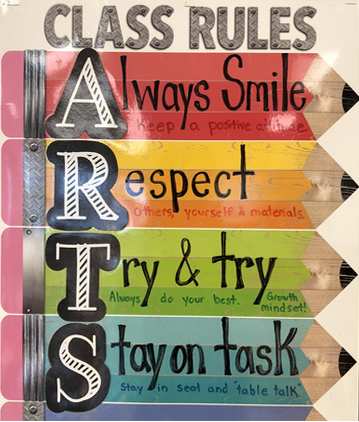Managing The Art Classroom: Art Rules
Art Rules: Having simple rules can help ensure that students are safe and prevent misbehavior from occurring before they begin. I introduce these rules not as something negative but rather as a measure to ensure that students are creating the best environment to nurture their learning.
Always Smile: This rule is a reminder for students to keep a positive attitude and demonstrate a growth mindset.
Respect: This rule is a reminder to students to respect themselves, each other, the art materials, and the classroom.
Try & try: I like to challenge my students. But because I challenge them, it can be difficult to learn a new skill. This is a reminder that it is not about being the best, but rather trying your best.
Stay on task: This rule serves as a reminder for students to stay in their seat and focus on their work. The time they have in art is limited so they need to remain at their table so that they can complete their work.
Consequences: consequences should be a part of all classroom management plans. They should be fair, concise, and easy to follow. In addition, these consequences should be made clear from the beginning of the year and should be visible to students.
Examples of consequences can include:
1. Verbal warning- Give a verbal warning to student(s) explaining what rule(s) they broke and what will happen if they continue this behavior.
2. Cool Out Corner- This is a table located in the back of the room. Once there, students can choose to work on their art or just take a moment to “cool down” and reset. (At this table I have fidgets, a sand timer, and a book called “The Way I Feel” by Janan Cain)
3. Reflection- This is a form where students will write and/or draw what happened, why they did it, and what actions they will take next.
4. Parent communication- If warranted, that reflection would be sent home for a parent signature and the parents will be contacted.

Art Points: points systems can add a measure of teamwork, competition, and accountability that reinforces and supports my other behavior management strategies. art educators can work with other specialists in their school to create a point system that is consistent across all specials.
As part of my classroom management plan I have points that are awarded to classes based on whole-group expectations. For each art class, a group can earn up to a total of five points. The points are earned as follows:
1. Entering: Entering the classroom quietly.
2. Listening: Listening attentively to the day’s lesson and directions.
3. Studio Work: Focusing on completing their work & following directions.
4. Clean Up: Following the clean up routines and procedures.
5. Dismissal: Lining up and leaving the room quietly.
3. Studio Work: Focusing on completing their work & following directions.
4. Clean Up: Following the clean up routines and procedures.
5. Dismissal: Lining up and leaving the room quietly.
Tracking Art Points: At the end of each class, once students have lined up I go over the points that they earned that day with their teacher and explain why they did or did not earn their points. If a class has earned all 5 of their points that day they get to celebrate with a classroom cheer.
I work with the other specialists in my school (art, music, PE, media) to make sure that the point system is consistent across all specials. At the end of each class, I record the points on a chart by my door. Every week myself and the other specialists enter these points into an excel spreadsheet. At the end of each quarter the class(es) with the most amount of points in all of their specials earns the “Super Special Specials Trophy.” Not only do they get to proudly display this trophy in their classroom, they also get to have a special celebration. This system provides students with a sense of pride and accomplishment when it is achieved and it also acts as an incentive for other classes to earn the most points each quarter.




Comments
Post a Comment